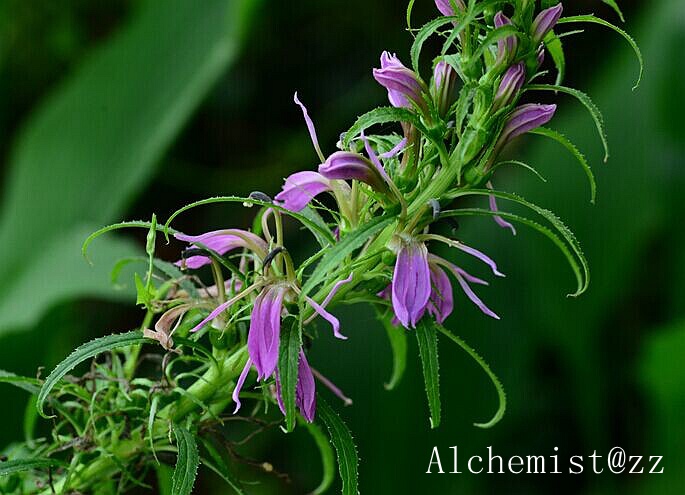- Scientific Name: Lobelia davidii Franch.
- Ref: Nouv. Arch. Mus. Hist. Nat., sér. 2, 6:71. 1883
- Synonyms: Lobelia dolichothyrsa Diels; L. kwangsiensis E.Wimm.; L. oligantha C.Y.Wu; L. sichuanensis (Y.S.Lian) D.Y.Hong; L. tibetica W.L.Cheng
- Chinese Common Name: 江南山梗菜 jiāngnán shāngěngcài, 苦菜 kǔcài, 节节花 jiéjiéhuā
- Family: Campanulaceae
- Genus: Lobelia
- Distribution: Forest margins, by streams; below 4000 m. Anhui, Fujian, Guangdong, Guangxi, Guizhou, Hubei, Hunan, Jiangxi, Sichuan, S Xizang (Cona, Yadong), Yunnan, Zhejiang [Bhutan, N India, Myanmar, Nepal].
- Photo: 09/03/2014, Hangzhou Botanical Garden, Zhejiang
Herbs, perennial, up to 180 cm. Stems erect, simple or branched, usually densely hispidulous or scaberulose. Leaves alternate, lower leaves usually petiolate; petiole winged, up to 4 cm; blade ovate-elliptic to linear-lanceolate, up to 17 × 7 cm, abaxially glabrous or hispidulous, adaxially glabrous, base cuneate, apex acuminate. Racemes terminal, 20-50 cm, inflorescence rachises glabrous to densely hispidulous; bracts ovate-lanceolate to lanceolate, longer than flowers; pedicels 3-5 mm, usually hispidulous, with 1 or 2 minute bracteoles near base. Hypanthium obovoid, ca. 4 mm, rounded at base, sparsely to densely scaberulose; calyx lobes linear-lanceolate, 5-12 × 1-1.5 mm, margin denticulate. Corolla nearly 2-lipped, purple-red or red-purple, 1.1-2.8 cm; upper lobes linear; lower lobes narrowly elliptic or lanceolate-elliptic, glabrous or puberulent, villous below throat. Stamens connate above base; filament tube glabrous or puberulent near anthers; lower 2 anthers barbate at top. Capsule globose, 6-10 in diam. Seeds yellow-brown, slightly compressed, one side thicker than other. Fl. and fr. Aug-Oct. (Flora of China)
